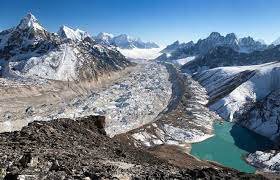
Glacial retreat in The Himalayas is forebode of menacing future not only on the geography but the billions of people who depends on this uniquely build vast ecosystem for their end meet.
After Antarctica and Arctic Himalayas is the third-largest glaciers on the planet. The Himalayan glaciers are dwindling over time, it may have lost as much as a quarter of their enormous mass in the last four decades. The amount of ice has melted from 1975 to 2000 has doubled since then. Scientists have waned by 2060-2070 may the glaciers have practically gone.
The glaciers on Himalaya are distributed over three main glacial basins, Indus, Ganga and Brahmaputra. These three basins have 16,049, 6,237 and 10,106 glaciers that occupy an area of 32,246, 18,393 and 20,543 sq. km respectively. (As per the glacial inventory of Space Application Centre (ISRO))
Cause of glacier melting-
We, humans, have not left any nook of the planet unravaged and The Himalayas is no exception. The 32,392 Numbers spectacular glaciers of the Himalayas are on the verge of liquefaction. Even if we boil-down all the causes, global warming is ultimate factor of glacier melting.
*Greenhouse gases are a major threat to glaciers. These gases trap heat in the atmosphere which leads to the rise of temperature this consequently influences the melting of glaciers. Greenhouse gases like carbon dioxide, methane, nitrous oxide are produced by fossil fuel, biogas combustion. We claim to be in an advanced era but still not find any potential alternative for the petrochemical fuel.
*Deforestation has disrupted the ecological balance of the Himalayan region. Carbon dioxide is absorbed by trees. The denuded forest has led to a high concentration of carbon in the atmosphere entailing a rise in temperature that melts the glaciers. If this pressing issue will not taken into account the ice shrouded mountains are expected to disappear one day.
*Seems to be unbelievable but dust is a significant cause of glacial melting in the Himalayan region. Desert dust from as far as Saudi Arabia gets picked up by spring wind and deposited on the western side of the mountain. Dust particles polluted the air and accelerate snow melting. Besides that industrial effluents is a dominant driver of glacial melting. The surface snow reflects 90% of the incoming sunlight but the dust-filled air absorbs the sunlight that increases temperature and facilitates the melting of the glaciers. The dilemma is the intensity of the melting process is only poised to increase. (Published in the journal Nature Climate Change)
Effect of Glacier Melting
Himalayan glaciers are the source of some major river systems of Asia and the unique colossal ecosystem is the lifeline of the one-third population of the globe. Glacier retreating is havoc king catastrophic devastation in the region in the form of terrific avalanche, massive floods, horrific land sliding taking tools on the people and possessions. The perennial rivers will dry up without glaciers and the Indian peninsula will become a parched barren land.


I was very pleased to discover this site. I wanted to thank you for ones time due to this wonderful read!! I definitely loved every little bit of it and I have you saved as a favorite to check out new things in your website.
Very good post. I certainly appreciate this site. Continue the good work!